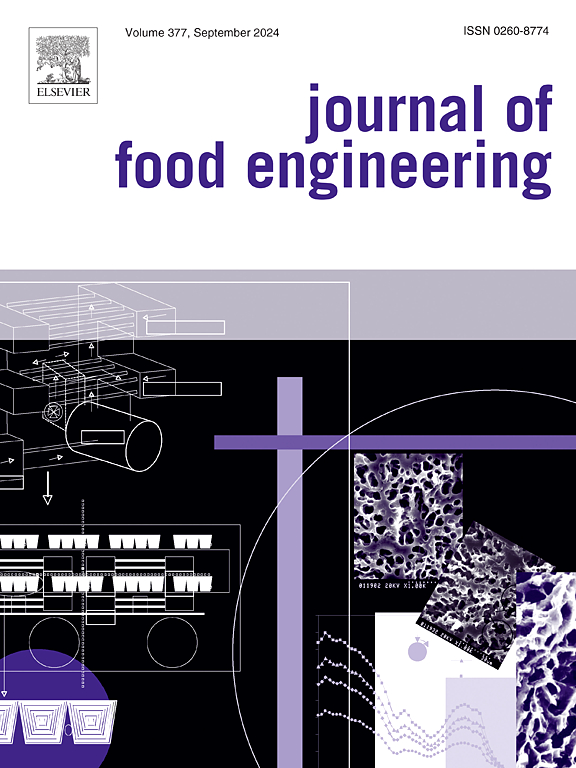果胶酪蛋白酸中的姜黄素提高白藜芦醇的生物利用度
IF 5.8
2区 农林科学
Q1 ENGINEERING, CHEMICAL
引用次数: 0
摘要
白藜芦醇和姜黄素是具有抗氧化、抗炎和抗癌特性的天然植物源多酚,但生物利用度和稳定性较差。递送系统提供了解决这些限制的有效策略。值得注意的是,它们的共包封表现出协同效应,显著提高了包封效率、稳定性和生物活性。本研究以果胶和酪蛋白酸钠为原料,采用溶剂蒸发和静电沉积相结合的方法制备了传递白藜芦醇和姜黄素的纳米颗粒,并对其理化性质和结构特性进行了表征。PE-SC-C-RNP粒径分布窄(247.57 nm),多分散性指数低(0.32),包封效率高(95.24±0.76%)。结构分析表明,果胶与酪蛋白酸钠静电相互作用形成纳米粒子外层,白藜芦醇和姜黄素呈无定形。体外消化实验表明,姜黄素增强了白藜芦醇与载体的结合,但不影响白藜芦醇或游离氨基酸的释放速度,导致抗氧化活性显著提高。动物模型实验表明,PE-SC-C-RNP小鼠血浆中白藜芦醇浓度高于口服白藜芦醇纳米颗粒小鼠,最大组织浓度提高0.83 - 1.27倍,药代动力学更好。给药后6.0 h内,白藜芦醇在肝脏、肾脏和其他组织中的最大组织浓度增加了0.83 - 1.27倍。这些结果表明,果胶酪蛋白酸钠纳米颗粒和共包被的姜黄素有效地提高了白藜芦醇的生物利用度,以传递生物活性化合物。本文章由计算机程序翻译,如有差异,请以英文原文为准。

Curcumin in pectin-caseinate enhances resveratrol bioavailability
Resveratrol and curcumin, natural plant-derived polyphenols with antioxidant, anti-inflammatory, and anticancer properties, are limited by poor bioavailability and stability. Delivery systems offer an effective strategy to address these limitations. Notably, their co-encapsulation shows synergistic effects, significantly enhancing encapsulation efficiency, stability, and bioactivity. In this study, nanoparticles were prepared from pectin and sodium caseinate to deliver resveratrol and curcumin using a solvent evaporation method combined with electrostatic deposition, and their physicochemical and structural properties were characterized. The nanoparticles (PE-SC-C-RNP) had a narrow size distribution (247.57 nm), low polydispersity index (0.32), and high encapsulation efficiency (95.24 ± 0.76 %). Structural analyses indicated that electrostatic interactions between pectin and sodium caseinate formed the nanoparticle outer layer, with resveratrol and curcumin in an amorphous state. In vitro digestion experiments showed that curcumin enhanced the binding of resveratrol to carriers without affecting the release rate of resveratrol or free amino acids, leading to a significant increase in antioxidant activity. Animal model experiments showed that the resveratrol concentrations were greater in the plasma of mice administered PE-SC-C-RNP than those administered nanoparticles encapsulating only resveratrol orally, with a 0.83–1.27-fold increase in the maximal tissue concentration, and better pharmacokinetics. The maximum tissue concentration of resveratrol increased 0.83–1.27-fold in the liver, kidney, and other tissues within 6.0 h of administration. These results demonstrated that pectin sodium caseinate nanoparticles and co-encapsulated curcumin effectively improved the bioavailability of resveratrol for the delivery of bioactive compounds.
求助全文
通过发布文献求助,成功后即可免费获取论文全文。
去求助
来源期刊

Journal of Food Engineering
工程技术-工程:化工
CiteScore
11.80
自引率
5.50%
发文量
275
审稿时长
24 days
期刊介绍:
The journal publishes original research and review papers on any subject at the interface between food and engineering, particularly those of relevance to industry, including:
Engineering properties of foods, food physics and physical chemistry; processing, measurement, control, packaging, storage and distribution; engineering aspects of the design and production of novel foods and of food service and catering; design and operation of food processes, plant and equipment; economics of food engineering, including the economics of alternative processes.
Accounts of food engineering achievements are of particular value.
 求助内容:
求助内容: 应助结果提醒方式:
应助结果提醒方式:


